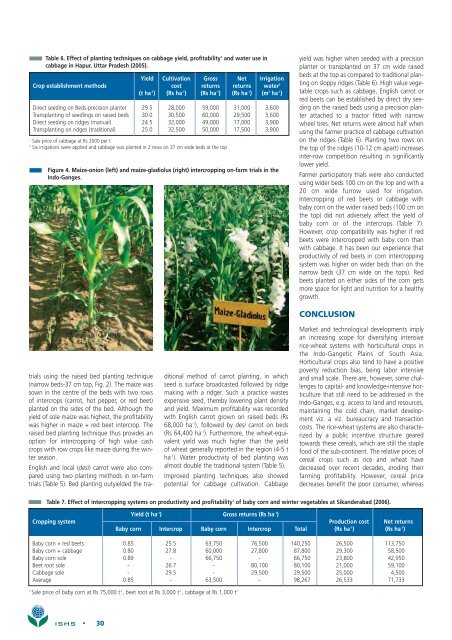Acta Horticulturae
Acta Horticulturae
Acta Horticulturae
Create successful ePaper yourself
Turn your PDF publications into a flip-book with our unique Google optimized e-Paper software.
Table 6. Effect of planting techniques on cabbage yield, profitability 1 and water use in<br />
cabbage in Hapur, Uttar Pradesh (2005).<br />
Yield Cultivation Gross Net Irrigation<br />
Crop establishment methods cost returns returns water 2<br />
(t ha -1 ) (Rs ha -1 ) (Rs ha -1 ) (Rs ha -1 ) (m 3 ha -1 )<br />
Direct seeding on Beds-precision planter 29.5 28,000 59,000 31,000 3,600<br />
Transplanting of seedlings on raised beds 30.0 30,500 60,000 29,500 3,600<br />
Direct seeding on ridges (manual) 24.5 32,000 49,000 17,000 3,900<br />
Transplanting on ridges (traditional) 25.0 32,500 50,000 17,500 3,900<br />
1<br />
Sale price of cabbage at Rs 2000 per t<br />
2<br />
Six irrigations were applied and cabbage was planted in 2 rows on 37 cm wide beds at the top<br />
Figure 4. Maize-onion (left) and maize-gladiolus (right) intercropping on-farm trials in the<br />
Indo-Ganges.<br />
yield was higher when seeded with a precision<br />
planter or transplanted on 37 cm wide raised<br />
beds at the top as compared to traditional planting<br />
on sloppy ridges (Table 6). High value vegetable<br />
crops such as cabbage, English carrot or<br />
red beets can be established by direct dry seeding<br />
on the raised beds using a precision planter<br />
attached to a tractor fitted with narrow<br />
wheel tires. Net returns were almost half when<br />
using the farmer practice of cabbage cultivation<br />
on the ridges (Table 6). Planting two rows on<br />
the top of the ridges (10-12 cm apart) increases<br />
inter-row competition resulting in significantly<br />
lower yield.<br />
Farmer participatory trials were also conducted<br />
using wider beds 100 cm on the top and with a<br />
20 cm wide furrow used for irrigation.<br />
Intercropping of red beets or cabbage with<br />
baby corn on the wider raised beds (100 cm on<br />
the top) did not adversely affect the yield of<br />
baby corn or of the intercrops (Table 7).<br />
However, crop compatibility was higher if red<br />
beets were intercropped with baby corn than<br />
with cabbage. It has been our experience that<br />
productivity of red beets in corn intercropping<br />
system was higher on wider beds than on the<br />
narrow beds (37 cm wide on the tops). Red<br />
beets planted on either sides of the corn gets<br />
more space for light and nutrition for a healthy<br />
growth.<br />
trials using the raised bed planting technique<br />
(narrow beds-37 cm top, Fig. 2). The maize was<br />
sown in the centre of the beds with two rows<br />
of intercrops (carrot, hot pepper, or red beet)<br />
planted on the sides of the bed. Although the<br />
yield of sole maize was highest, the profitability<br />
was higher in maize + red beet intercrop. The<br />
raised bed planting technique thus provides an<br />
option for intercropping of high value cash<br />
crops with row crops like maize during the winter<br />
season.<br />
English and local (desi) carrot were also compared<br />
using two planting methods in on-farm<br />
trials (Table 5). Bed planting outyielded the traditional<br />
method of carrot planting, in which<br />
seed is surface broadcasted followed by ridge<br />
making with a ridger. Such a practice wastes<br />
expensive seed, thereby lowering plant density<br />
and yield. Maximum profitability was recorded<br />
with English carrot grown on raised beds (Rs<br />
68,000 ha -1 ), followed by desi carrot on beds<br />
(Rs 64,400 ha -1 ). Furthermore, the wheat-equivalent<br />
yield was much higher than the yield<br />
of wheat generally reported in the region (4-5 t<br />
ha -1 ). Water productivity of bed planting was<br />
almost double the traditional system (Table 5).<br />
Improved planting techniques also showed<br />
potential for cabbage cultivation. Cabbage<br />
CONCLUSION<br />
Market and technological developments imply<br />
an increasing scope for diversifying intensive<br />
rice-wheat systems with horticultural crops in<br />
the Indo-Gangetic Plains of South Asia.<br />
Horticultural crops also tend to have a positive<br />
poverty reduction bias, being labor intensive<br />
and small scale. There are, however, some challenges<br />
to capital- and knowledge-intensive horticulture<br />
that still need to be addressed in the<br />
Indo-Ganges, e.g. access to land and resources,<br />
maintaining the cold chain, market development<br />
viz. a viz. bureaucracy and transaction<br />
costs. The rice-wheat systems are also characterized<br />
by a public incentive structure geared<br />
towards these cereals, which are still the staple<br />
food of the sub-continent. The relative prices of<br />
cereal crops such as rice and wheat have<br />
decreased over recent decades, eroding their<br />
farming profitability. However, cereal price<br />
decreases benefit the poor consumer, whereas<br />
Table 7. Effect of intercropping systems on productivity and profitability 1 of baby corn and winter vegetables at Sikanderabad (2006).<br />
Yield (t ha -1 ) Gross returns (Rs ha -1 )<br />
Cropping system Production cost Net returns<br />
Baby corn Intercrop Baby corn Intercrop Total (Rs ha -1 ) (Rs ha -1 )<br />
Baby corn + red beets 0.85 25.5 63,750 76,500 140,250 26,500 113,750<br />
Baby corn + cabbage 0.80 27.8 60,000 27,800 87,800 29,300 58,500<br />
Baby corn sole 0.89 - 66,750 - 66,750 23,800 42,950<br />
Beet root sole - 26.7 - 80,100 80,100 21,000 59,100<br />
Cabbage sole - 29.5 - 29,500 29,500 25,000 4,500<br />
Average 0.85 - 63,500 - 98,267 26,533 71,733<br />
1<br />
Sale price of baby corn at Rs 75,000 t -1 , beet root at Rs 3,000 t -1 , cabbage at Rs 1,000 t -1<br />
ISHS • 30
















